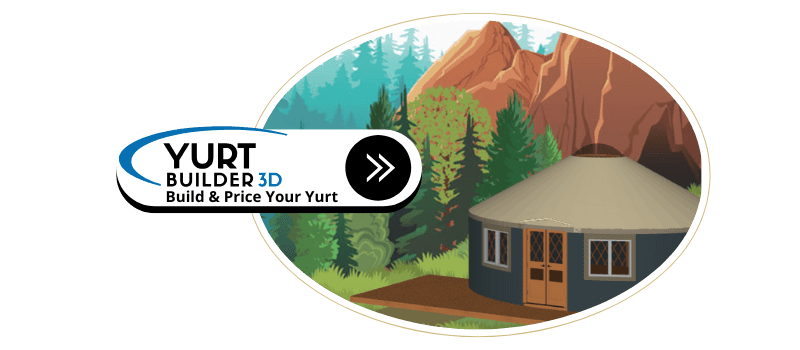There are a number of ways to install yurt heating; almost any conventional method can be used. Many of our customers prefer wood stoves, others choose pellet or propane stoves, some use central heating, electric heaters or ductless heat pumps, and some even put in radiant floor heating. If ductwork is required for any heating solution, it can be installed below the yurt floor.
Wood stoves are very common with yurt owners, but gas stoves work great too. We do recommend that a heating specialist be consulted with the installation of any heating solution and that local codes be checked before beginning.
A large, quality airtight stove puts out uniform heat over a long period of time. Yurt owners tend to agree that a yurt stove needs to be larger than what is recommended for a conventional room of the same size. The reason for this is that a yurt may have a little higher rate of heat loss than a conventional building, and yurts have a high ceiling making more cubic volume.
Download our Stovepipe Installation Guide
Steps to Installing a Yurt Stove
Step 1: Install the Base
Always install a stove on a fireproof base following the stove manufacturer’s guidelines for specific clearances from combustible surfaces. Make-up air for the wood stove may be provided through a vent in the floor adjacent to the stove if necessary.
Step 2: Install the Stovepipe Vent
We strongly recommend that the pipe for a yurt stove be installed through the wall rather than the ceiling. There are several reasons for this:
- It makes for easy access to the chimney for regular cleaning and upkeep.
- It minimizes the soot or ash that falls onto the roof, resulting in less maintenance for the yurt itself.
- It means the stove placement can be along any wall and the open concept maintained.
- A seal is easily achieved using our flashing kit.
Basic steps for adding the stovepipe vent:
- Pick a spot on the side of the yurt where prevailing winds will carry the smoke and ash away from the roof. With a woodstove, ideally this location is not too far from the door, so bringing wood in doesn’t require crossing the yurt interior with muddy feet, debris and extra steps. Then, cut the lattice wall using a hand saw leaving a diamond-shaped opening in the lattice wall.
- Center the six-sided interior flashing over the exit hole. Using a pencil, trace the flashing’s center hole onto the side cover (or sidewall insulation) and remove the flashing. This is where the insulated stovepipe will go through the wall. Using this circle as a reference, draw a larger circle with a radius that is 2″ larger. This is where the side cover will be cut so that none of the material is closer than 2″ from the insulated stovepipe. If your yurt has the Snow and Wind Kit, you may need to adjust the circle to the left or right to maintain the 2″ clearance from the rafter supports.
- Using a sharp pair of scissors, cut and remove the (larger) circle of fabric.
- Attach the interior flashing to the lattice wall with the screws provided. Be sure to drill pilot holes first to avoid splitting the lath.
- Attach the (rectangular) exterior flashing in the same manner by screwing through the side cover (drilling pilot holes first) into the lattice wall making sure the opening is exactly lined up with the interior flashing’s hole. The top of the flashing should be slipped under the top cover valance (roof overhang) to act as a shingle for protection against leakage.
Step 3: Install the Exterior Chimney
The exterior chimney, made from an insulated stovepipe, is typically supported by two 4×4 posts mounted next to the yurt. They should be 14″-16″ from the wall and 8″ apart. Dig a hole deep enough to provide stability, making adjustments for the height of the posts, soil conditions, and frost heave, and set the posts into concrete.
The cleanout tee is a 90-degree section of pipe that includes cleanout access. This will be supported by a chimney wall support kit, which is a shelf made from sheet metal that bolts directly to the 4×4 posts. Attach the straight sections of the chimney stovepipe onto the cleanout tee.
The top section of the pipe should include a chimney cap. The wall band is a metal strap that fastens around the chimney stovepipe and bolts to the 4×4 posts to secure the upper portion of the chimney, high enough to be fastened onto the uppermost section of piping.
Step 4 (Gas Stove): Install the Direct Vent Gas Stove Piping
The installation procedure for a gas stove will be the same as with a wood stove, except the exterior chimney will not be necessary. Instead of a cleanout tee, a gas stove will have a termination cap that mounts directly onto the exterior stove flashing.
Pacific Yurts Tips:
To complete any heating system, ceiling fans are recommended by many yurt owners to circulate the heat inside of the yurt. To keep the heat in during the cold spells, we offer insulated window covers and recommend installing insulation under the floor and skirting around the perimeter of the platform.




